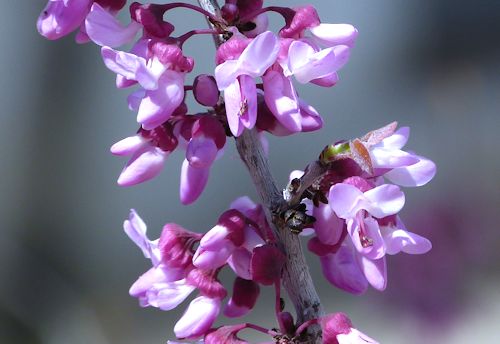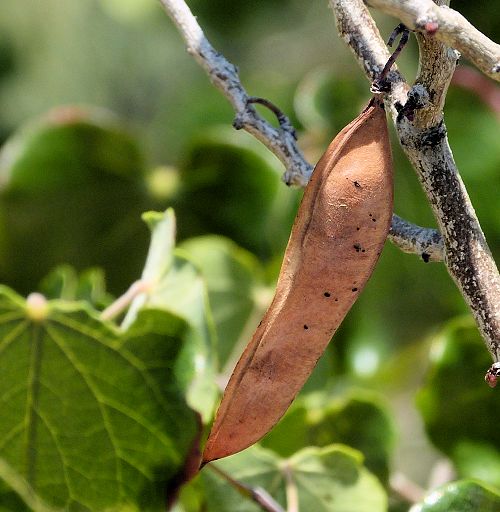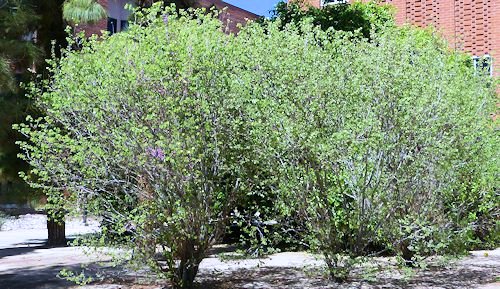Growing Cercis canadensis subsp. mexicana:
Mexican Redbud
Back to Trees and Palms
Description
Form: A shrub, or with pruning, a tree.
Leaf retention: Deciduous.
Growth rate: Slow.
Mature Size: 15-18' (4.5-5.5m) high and wide.
Flowers: Pink, appearing before leaf out, may persist as leaves develop, edible. The red buds stay closed for two weeks before opening, giving this plant its name.
Bloom: Mid winter to spring, depending on location.
Fruit: Seed pods, edible when young, drying to brown.
Leaves: Green, heart-shaped, smooth with undulating margins, leathery, turning yellow in the fall. This plant provides medium shade.
Stems: Multi-trunked and multi-branched.
Roots: This is one of the few members of the Legume family that does not have root nodules which perform nitrogen-fixing.
Wildlife: The flowers attract butterflies and bees. The seeds attract birds.
Toxic / Danger: No.
Origin: Texas and Mexico.
Form: A shrub, or with pruning, a tree.
Leaf retention: Deciduous.
Growth rate: Slow.
Mature Size: 15-18' (4.5-5.5m) high and wide.
Flowers: Pink, appearing before leaf out, may persist as leaves develop, edible. The red buds stay closed for two weeks before opening, giving this plant its name.
Bloom: Mid winter to spring, depending on location.
Fruit: Seed pods, edible when young, drying to brown.
Leaves: Green, heart-shaped, smooth with undulating margins, leathery, turning yellow in the fall. This plant provides medium shade.
Stems: Multi-trunked and multi-branched.
Roots: This is one of the few members of the Legume family that does not have root nodules which perform nitrogen-fixing.
Wildlife: The flowers attract butterflies and bees. The seeds attract birds.
Toxic / Danger: No.
Origin: Texas and Mexico.
Cultivation and Uses
USDA hardiness zones: 6-9.
Heat tolerant: Yes.
Drought tolerant: Yes.
Sun: Full sun to part shade.
Soil: This plant is tolerant of soil types and accepts pH 5.6-8.5 (acidic to alkaline) soil.
Water after becoming established: Once or twice a month. Less water is needed in part shade.
Prune: Pruning is required to develop a strong structure.
Litter: Seedpods, leaves in fall.
Propagation: Seed.
Uses: Ornamental, shade. The edible flowers and buds can be used in salads. The young seed pods can be eaten raw, sautéed, or boiled.
USDA hardiness zones: 6-9.
Heat tolerant: Yes.
Drought tolerant: Yes.
Sun: Full sun to part shade.
Soil: This plant is tolerant of soil types and accepts pH 5.6-8.5 (acidic to alkaline) soil.
Water after becoming established: Once or twice a month. Less water is needed in part shade.
Prune: Pruning is required to develop a strong structure.
Litter: Seedpods, leaves in fall.
Propagation: Seed.
Uses: Ornamental, shade. The edible flowers and buds can be used in salads. The young seed pods can be eaten raw, sautéed, or boiled.
Comments
This plant is a member of the Legume family (Fabaceae). Its scientific synonym is Cercis canadensis var. mexicana. It is smaller, and more heat and drought tolerant than the Eastern and Texas Redbuds.
Do you have additional information or a different experience for these plants that you would like to share? Email info@GardenOracle.com. All contributions are welcome and appreciated.
This plant is a member of the Legume family (Fabaceae). Its scientific synonym is Cercis canadensis var. mexicana. It is smaller, and more heat and drought tolerant than the Eastern and Texas Redbuds.
Do you have additional information or a different experience for these plants that you would like to share? Email info@GardenOracle.com. All contributions are welcome and appreciated.




Latest update: September, 2024
© 2008-2025 by GardenOracle.com

